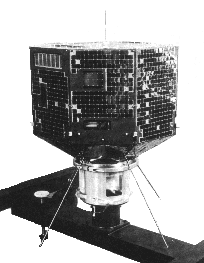The Hakucho [CORSA-B] Satellite (original) (raw)
 Corsa-B was the first X-ray astronomy Japanese satellite. Launched on 21 February 1979, it was renamed Hakucho (Japanese for swan) symbolizing one of the most interesting X-ray objects, Cyg X-1. As many other X-ray satellite launched in that period, Hakucho was designed to study and monitor transient phenomena with particular emphasis on X-ray bursts. It was still operating when the second X-ray Japanese satellite Tenma launched in 1983.
Corsa-B was the first X-ray astronomy Japanese satellite. Launched on 21 February 1979, it was renamed Hakucho (Japanese for swan) symbolizing one of the most interesting X-ray objects, Cyg X-1. As many other X-ray satellite launched in that period, Hakucho was designed to study and monitor transient phenomena with particular emphasis on X-ray bursts. It was still operating when the second X-ray Japanese satellite Tenma launched in 1983.
Mission Characteristics
![]() Lifetime : 21 February 1979 - 16 Aprile 1985
Lifetime : 21 February 1979 - 16 Aprile 1985![]() Energy Range : 0.1 - 100 keV
Energy Range : 0.1 - 100 keV![]() Payload :
Payload :
- Very Soft X-ray (VSX) experiment 0.1-0.2 keV
Four units of proportional counters
each with eff area ~ 78 cm2
Two parallel to the spin axis FOV = 6.3° X 2.9° FWHM
two offset FOV = 24.9° X 2.9° FWHM - Soft X-ray (SFX) 1.5-30 keV Six units of proportinal counters
Parallel to the spin axis :- Two FOV 17.6 deg FWHM; eff area=69 cm2 each
- Two FOV 5.8 deg FWHM; eff area=40&83 cm2
Two offset FOV = 50.3° X 1.7° FWHM eff area =32 cm2 each
- Hard X-ray (HDX) 10-100 keV scintillator
FOV 4.4° X 10.0° FWHM eff area =45 cm2 Science Highlights:
Science Highlights: - Discovery of soft X-ray transient Cen X-4 and Apl X-1
- Discovery of many burst sources
- Long-term monitoring of X-ray pulsar (e.g. Vela X-1)
- Discovery of 2 Hz variability in the Rapid Burster later named Quasi Period Oscillation.
 Archive : No data available at HEASARC
Archive : No data available at HEASARC
[Hakucho Home] [About Hakucho] [Gallery] [Publications]
[All Missions] [by Time] [by Energy]
Page authors: Lorella Angelini Jesse Allen
HEASARC Home | Observatories | Archive | Calibration | Software | Tools | Students/Teachers/Public
Last modified: Thursday, 24-Sep-2020 19:31:47 EDT